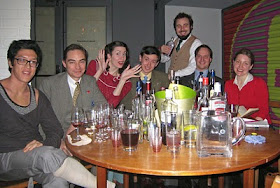 |
| Some bitters are now sold with one specific benefit in mind |
Given that alcohol is, most of the time, fundamentally bad for you, it’s interesting how often we as a species turn to it in the hope that it will improve our health. I suppose there is the idea that anything that makes you feel good must be doing you good, plus the known preservative capabilities: in fact in many cases the alcohol may simply be a vehicle for the cure. But there is an interesting cycle of medicine and recreation. Gin started life probably as a tincture of health-giving juniper berries; by the time Englishmen in far-flung malarial parts of the Empire were looking for something to wash down their medicinal quinine the gin to which they turned was fully recreational. And it was not long before the quinine tonic was being consumed for fun too.
 |
| Dr Leizaola explains the medicinal/recreational interface to DBS |
Here among things we recognise, such as Angostura, Peychaud’s and the offerings of the Bitters Truth, we see Yoyo, Taabea, Adutwumwai and Dr Aladdin’s The 7 Keys. Dr Laizaola makes a good point by showing how one can buy Dandelion and Burdock Bitters marketed as a cocktail ingredient at the same time that you can buy it as a health-giving tonic—ironically even as a “detox” tincture (and this is something that is 45% alcohol). It’s easy to forget how herbal snifters such as Jägermeister, Becherovka and Chartreuse were originally medicinal.
 |
| "Gin bitters"—apparently rather tasty |
one of the most popular bitters, with a peppery flavor and clear colour. Radishes are also macerated in rum or vodka as a warmer and appetizer—it tastes quite good despite the funny smell!” I think we’re going to have to get busy in the Institute’s lab…
Other products, once sold as a cure-all, are now marketed in some parts of the world entirely as enhancers of male sexual potency—a video screen shows a TV commercial for Mamajuana Kalembu, from the Dominican Republic, in which a young buck eyes a nymph emerging from the sea towards him…then straight past him into the arms of a goofy nerd. His secret? You guessed it. Meanwhile one Caribbean product seems to rely solely on its name—“Bedroom Bully”—to make the point, while Mighty Power and Resurrection Formula don’t leave too much to the imagination either.
The actual content of these tinctures varies enormously: in London markets you can buy dry herb/spice/bark mixes so you can knock up you own mamajuana and Dr Leizaola bought a few examples, clearly containing different ingredients, despite claiming to be the same thing. Perhaps it’s all a testament to our universal need to believe we can change our health and fortunes by eating strange, rare things.
In parts of Africa there is a tradition of “gin bitters”. English colonists brought with them their own traditional infusions—gin and tonic—and the name stuck. (I had guessed that the oddly-named King George Bitters—“God’s Blessing”—which claims to cure at least seven different ailments, hailed from some ex-colony, as I know that Trinidad’s Angostura* was an official supplier of bitters to George V, but Dr Leizaola tells me it actually comes from this country.)
Now Ghanian Herb Afrik Gin Bitters is sold** for recreational consumption too—and is actually Dr Leizaola’s top tip for tastiness, along with Alomo Bitters from the Kasapreko company, also in Ghana. Expect some cocktail recipes on this blog soon.
More photos from the exhibition may be found at our Flickr page.
Dr Leizaola’s tip for buying many of these products is Kumasi Market in Granville Arcade, Brixton, London.
* Actually invented by a German doctor in Venezuala, as a cure for stomach upset and fever.
** By GIHOC Distilleries—who also produce a couple of "gins" based on molasses spirit, which sound intriguing.
 |
| Even today restorative/detoxifying tinctures are sold as a conceptual opposite of booze, yet containing as much alcohol by volume as whisky |
In parts of Africa there is a tradition of “gin bitters”. English colonists brought with them their own traditional infusions—gin and tonic—and the name stuck. (I had guessed that the oddly-named King George Bitters—“God’s Blessing”—which claims to cure at least seven different ailments, hailed from some ex-colony, as I know that Trinidad’s Angostura* was an official supplier of bitters to George V, but Dr Leizaola tells me it actually comes from this country.)
Now Ghanian Herb Afrik Gin Bitters is sold** for recreational consumption too—and is actually Dr Leizaola’s top tip for tastiness, along with Alomo Bitters from the Kasapreko company, also in Ghana. Expect some cocktail recipes on this blog soon.
More photos from the exhibition may be found at our Flickr page.
Dr Leizaola’s tip for buying many of these products is Kumasi Market in Granville Arcade, Brixton, London.
* Actually invented by a German doctor in Venezuala, as a cure for stomach upset and fever.
** By GIHOC Distilleries—who also produce a couple of "gins" based on molasses spirit, which sound intriguing.










































